博文
重视美国铁路华工建设中的华人图像 ----以Journal of Asian A
|||
重视美国铁路华工建设中的华人图像
----以Journal of Asian American Studies刊登四位华工图像为例
黄安年文 黄安年的博客/2017年6月29日发布
在收集、考察、研究19世纪中后期美国铁路华工活动中,重视美国铁路华工建设中的华人图像是很重要的,这些图像无论在太平洋铁路建设前的淘金热和加州建设热中,在19世纪60年代第一条太平洋铁路建设过程中,还是其后的四条太平洋铁路和加州铁路等建设中,甚至在20世纪之初,都非常重要。之所以重要是因为在此期间华工在美国历来处于沉默的少数,极少抛头露面,尤其是杰出的代表人物。而作为人物图像的照片具有原始性和形象确定性,当时不具备“换头术”技术水平,因而具有真实可靠性。配以文字资料佐证往往具有历史档案资料的原创性作用。当时的美国和中国的历史记叙轻视沉默的群体,如果文献资料中保存这些图像资料显然是弥足珍贵的。
我们既要注意尽可能地收集阿尔弗雷德哈特作为当年中央太平洋铁路公司专业摄影师和安德鲁拉塞尔作为联合太平洋铁路公司专业摄影师现场拍摄的极其珍贵的图像资料,也要收集各个著名图书馆、博物馆及铁路建设沿线和辐射地区的博物馆、图书馆、地方报刊等集中收集的原始图像资料。例如这里专门提及的美亚杂志1996年第6期上刊登的一篇“Asian Pioneers in the Eastern United States: Chinese Cutlery Workers inBeaver Falls, Pennsylvania, in the 1870s”文章,其中刊登了三位男性华工(图像来源the Beaver Falls Historical Society Museum)和以为华人妇女的照片。其中一位李天培经过笔者查对《李文庄公家乘》族谱记载,确认李天培和李天沛为同一家族(见《李文庄公家乘》族谱记载李天沛和李天培为同一家族---就美铁路华工包工头李天沛与李天培关系答黄倩,黄安年文黄安年的博客/2017年6月26日发布http://blog.sciencenet.cn/blog-415-1063098.html)但对李天培的详情依然知之甚少,尽管如此,确有其人这一历史要素已经肯定。相比之下李天沛、李天宽、李祐芹、李奕德的包工头照片如果找到不是很好吗?
而亚泽和赵安两人的情况有待其他资料来厘清情况,不过有了这一线束依然可喜。类似这样的图像资料很可能被淹没在大量报刊文献资料中,期望细心的人来发掘。(这篇文章是在美国的黄倩女士提供的,再次表示感谢)
再例如,昨天的博文《我看丁龙(Dean Lung)研究》黄安年的博客/2017年6月28日发布http://blog.sciencenet.cn/blog-415-1063430.html)中我提出:“从海龙发表的几篇考察丁龙(Dean Lung)文章中涉及的文献资料看, Dean Lung确有其人,主要依据是哥伦比亚大学档案资料有记载:1901年Dean Lung给哥大校长捐款12000美元的信件,Dean Lung服务于他的主人Horace Carpentier的证明,哥大东亚系记载1902年设立于哥伦比亚大学的专门研究中国文化与汉学的讲座(Dean Lung Professor),还有Dean Lung和Horace Carpentier的照片等等。没有任何质疑能够推翻这个历史存在的结论。”有人认为没有丁龙这个人,因而否定其真实性。问题在于Dean Lung确有其人,是否中文名字叫做丁龙是翻译问题,不能因此否定Dean Lung是个华人,图像证明就很重要。
我和李炬合著的《沉默道钉的足迹》一书的图片中有当年华工图像,苦于无法说明其名字,阿尔弗雷德是否知其名都难说,我们目前没有看到他有无摄影手记之类的自来保存。涉及1869年5月10日两路大军会师时的华人是否确实在场之类就难以以人名定论了,除非两大公司保留着当时的邀请名单纪录,尽管如此我们依然可以此案去县级技术来判定是否有华工,因为图像不能将白人拍成华工,这不是画像而是摄影。
图像还可能保存在美国的华人会馆于社团中,例如致公堂资料、几大会馆图片资料等需要有细心的人耐心查找。此外不排除上万封华工家书中可能夹带的图像照片。在我们的《沉默道钉的足迹》中有当年加州伐木工尹华的照片(第183页),这张照片迄今还保存在东莞家中。所以铁路华工后裔家庭保存的图像资料尤其珍贵。
当然如果仔细查找美国海关入境资料和护照那么中英文名字和照片都会有的。(同上书,第180-181页)
************************8
Asian Pioneers in theEastern United States: Chinese Cutlery Workers in Beaver Falls, Pennsylvania,in the 1870s
From: Journal of AsianAmerican Studies
Volume 2, Number 2, June 1999
pp. 119-155 | 10.1353/jaas.1999.0019
In lieu of an abstract, here is a brief excerpt of the content:
Asian Pioneers in the Eastern United States:
Chinese CutleryWorkers in Beaver Falls, Pennsylvania, in the 1870s
Figures
Click for larger view
View full resolution
Figure 1.
American Manufacturer (Pittsburgh), 23 November1876, p. 7; courtesy of the Carnegie Library of Pittsburgh.
Click for larger view
View full resolution
Figure 2.

Ah Chuck. Courtesy of theBeaver Falls Historical Society Museum;used with permission.
Click for larger view
View full resolution
Figure 3.
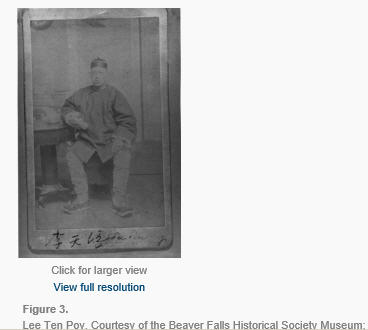
Lee Ten Poy. Courtesy ofthe Beaver Falls Historical Society Museum;used with permission.
Click for larger view
View full resolution
Figure 4.
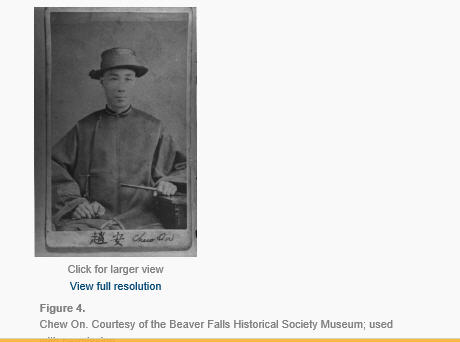
Chew On. Courtesy of the Beaver Falls Historical Society Museum; used withpermission.
Click for larger view
View full resolution
Figure 5.

Unidentified woman,probably Chew On’s wife. Courtesy of the Resource and ResearchCenter for Beaver Countyand Local History; used with permission.
By 1869 Chinese had been living and working in the United Statesin large numbers for twenty years, during which time their population had risento nearly 60,000. Until then, they were almost all confined to the Pacificcoast and the Rocky Mountains. With the completionof the transcontinental railroad in May of that year, however, they were ablefor the first time to venture east relatively easily, where coincidentallytheir labor was in sudden demand. For in both the rapidly industrializing Northand the post-Civil War South, factory workers and newly emancipated slaves wereexhibiting far too much independence to suit their respective bosses. TheChinese, it was thought, might provide a feasible solution to their problems.Thus, almost as soon as the Central Pacific and the Union Pacific wereconnected, sizable groups of Chinese began showing up in different parts of theeastern United States, tojoin the relative handful in Atlantic seaports who had come decades earlierwith the Chinatrade. In January 1870, 250 Chinese from Californiaarrived in Robertson county, Texas,to help build the Houston and Texas Central Railroad. Five months later, 75Chinese, also from California, detrained at North Adams, Massachusetts,to commence work in Calvin T. Sampson’s shoe factory. Others soon followed. Inthe south, 900 Chinese went to work on the Alabama and Chattanooga Railroad,and another 150 on the Millaudon sugar plantation near New Orleans, while inthe [End Page 119] North, 300 Chinese came to the Passaic Steam Laundryin Belleville, New Jersey, and an equal number to the Beaver Falls CutleryCompany in Beaver Falls, Pennsylvania. 1
Very little is known about these pioneering Asianseast of the Rockies, as scholarly attentionhas focused on their far more numerous fellow countrymen in the West.Furthermore, the handful of accounts that have been written about the Chinesein the East have dwelt not so much on the Chinese themselves as on thecontroversies, both pro and con, that their coming invariably engendered amongthe local population. The Chinese thus tend to come off in these studies not asthe subjects but as the passive objects of history, not as acting but as actedupon. Nevertheless, these controversies serve a useful purpose, for theyelicited practically all the information that is now available on these earlyChinese immigrants, who left few records of their own. This article attempts toovercome the inherent biases of the sources (mostly newspaper reports) andreconstruct the life and work of one of these first Asian American groups inthe eastern United States,the Chinese at the Beaver Falls Cutlery Company in the 1870s. It will alsocompare their experiences with those of other Chinese elsewhere in the East atthe time.
The Coming of the Chinese
Beaver Falls is asmall industrial town in southwestern Pennsylvania,twenty-eight miles northwest of Pittsburgh.It is situated on the Beaver River, three miles above its confluence with the Ohio, and served by a major east-west rail line, then thePittsburgh, Fort Wayne and Chicago Railroad. Aside fromits superior location, it is also well endowed with natural resources,including water, coal, and gas. As a result, it quickly developed in the early1870s into a regional manufacturing center, known particularly for itsproduction of hardware for...
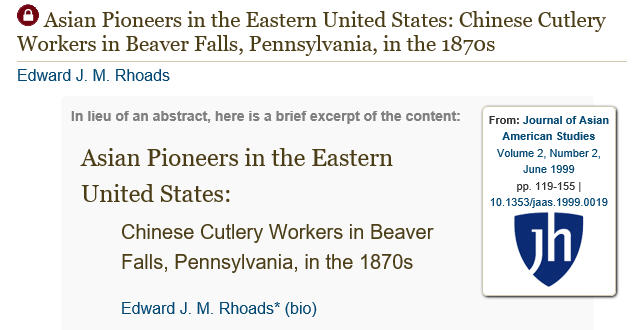
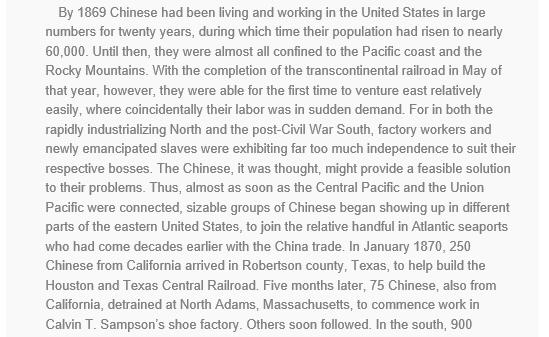
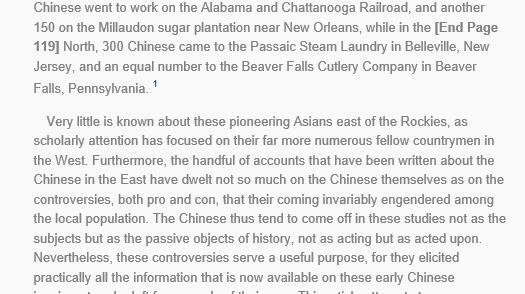

https://muse.jhu.edu/article/14556
https://wap.sciencenet.cn/blog-415-1063669.html
上一篇:我看丁龙(DeanLung) 研究
下一篇:北京有序推广为老楼加装电梯工程